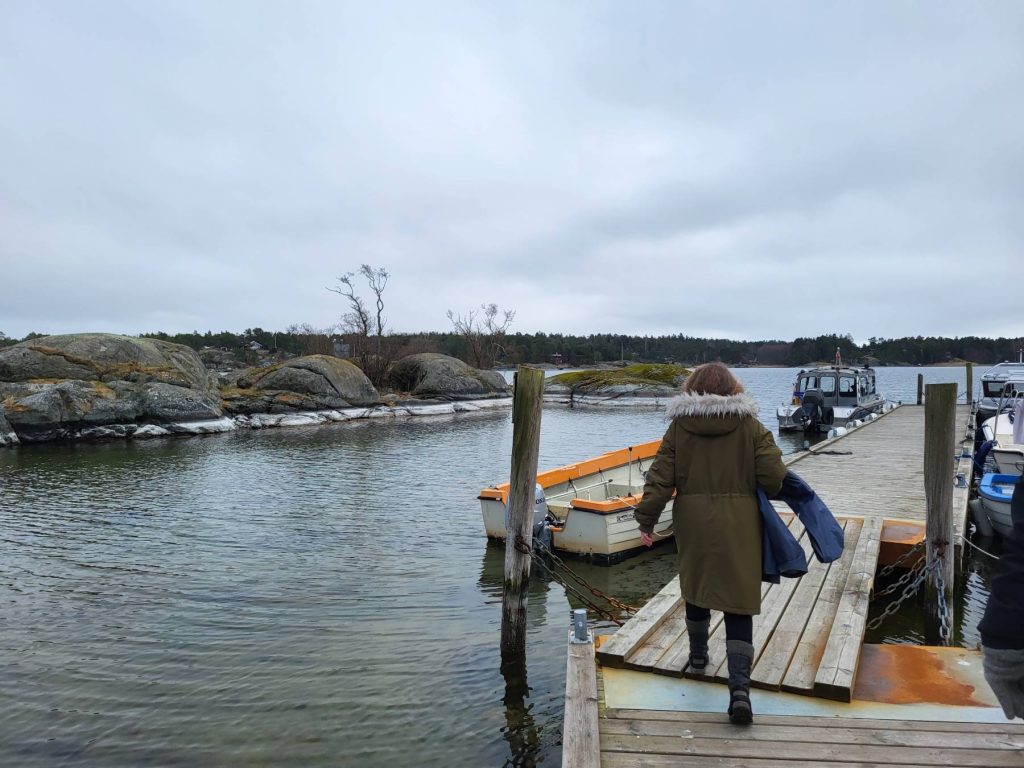In fall 2024, the Nämdö Archipelago Citizens’ Jury brought together 25 participants to discuss priorities for the planned biosphere reserve over two weekends. The film documents the purpose of the citizens’ council, how it came about and gathers the voices of participants and researchers who examine the process.
Author: Admin
Landpaths researchers within subproject urban landscapes and future imaginaries discussed the future of greenery in southern Uppsala with citizens and stakeholders during a short workshop in Sävja, southern Uppsala at the end of November 2024. The development of southern Uppsala has been a topic of discussion and public resistance after the municipality announced its plans to build housing for 50 000 new inhabitants in southeastern Uppsala that is currently inhabited by 10 000 people, by 2050 and a tram line connecting the southeast and southwest of the city.
Early in the morning of a grey and rainy Thursday in November, the café at Linnés Sävja filled with lively conversations between about 25 participants, including members of local outdoor associations, people working in culture and education, and representatives from different interest organisations. All had been invited by the urban landscapes and future imaginaries sub-projects within LANDPATHS to a workshop to discuss the future of green spaces in southern Uppsala.
Divided into five groups of about six people each, the participants greeted each other and were welcomed by Lara Tickle, postdoc in the urban landscapes subproject. Thereafter, Marcus Hedblom, professor in landscape architecture at SLU Uppsala and leader of the urban landscape subproject explained the latest scientific findings on the importance of urban green spaces.

Urban greenspaces important for human health, biodiversity and temperature control
In cities, 57% of all outdoor recreation happens in green urban spaces within a distance of 2km from the citizen’s home. Therefore, careful planning of the distribution of greenspace is important. The beneficial effect of greenery such as forests on human health has been shown to stem from visual appearance, sounds (e.g. bird song) and even scent. Children play more actively and creatively in forests as compared to playgrounds, where play takes on a more competitive nature.
Although fostering biodiversity is encouraged in urban green spaces, 51% of all green areas in cities are still lawns (managed grass). More effort is needed to add variety, especially as it is now known that both mental and physical diseases such as chronic inflammation, allergies and depression are increasing among the urban population and green spaces are a remedy for these city-life symptoms. In the light of climate change and longer heat waves in summers, green areas are also crucial since they provide shade and lower the ambient temperature.
Despite the fact that these positive effects are known and policies for creating urban green spaces exist, they are often not well integrated in practice and sustainability discussions become too frequently focused on grey elements (buildings) rather than green spaces.
Challenges for Southern Uppsala
Having listened to this information, the participants were asked to think about their own vision for southern Uppsala, and which opportunities and challenges they foresee. They were also asked to formulate a headline that they would like to see in the news in 2050, to describe the green spaces in Uppsala and how the urban landscape has changed since the completion of the planned development in southern Uppsala.
Given the ongoing heated debate about the planned development, the awareness of challenges was clearly sensed during the discussions. Participants mentioned a desire for more long-term perspectives during city planning, better knowledge among decision makers, a willingness to scrutinize current norms and improved integration of ecological, social and sustainability aspects in the planning phase, and enhanced participation among citizens.

An opportunity for multifunctionality
However, opportunities were also described, such as the proximity of southern Uppsala to an established nature reserve (Lunsen) that can be integrated as ‘grown green space’ with high biodiversity, the possibility to work with nature to foster integration in this neighborhood that has a significant contribution of immigrants, an opportunity for citizens to become active and to influence the decisions that are made, and an opportunity to connect culture and nature and create green multifunctional activity spaces. Participants proposed imaginary newspaper headlines for such scenarios that read “Uppsala succeeded in combining biodiversity and city development”, “Uppsala municipality rethinks city planning”, “Southeastern Uppsala – where citizens get to decide” and “The forest as a place for integration”.
Next steps
Another workshop will take place in March 2025, to continue the development of the visions for the area, and identify possible ‘seeds of change’ that would help the opportunities become a reality.
In June 2024, LANDPATHS researchers contributed to the NESS and POLLEN conferences through presentation of their research and by arranging workshops and panel discussions. We summarize here how these activities have encouraged discussion on multifunctional landscape governance in the Nordics.
LANDPATHS at the Nordic Environmental Social Science Conference
The 16th Nordic Environmental Social Science Conference (NESS) was held in Åbo, Finland early in June 2024. At this years edition of the biannual conference, environmental social science scholars as well as researchers from other disciplines discussed various aspects around the central topic “Co-creation for sustainability”. LANDPATHS researchers submitted manuscripts to two out of the 28 different workshops at NESS and co-organized a total of three workshops. The manuscripts submitted are listed below and will be sent to scientific journals for publication in the coming months.
- Blicharska G et al.: Landscape multifunctionality as a pillar of biodiversity governance? Insights from Sweden.
- Westerberg C, Tafon R, Gilek M: Navigating conflict and exclusion in conservation and sustainability governance of the Nämdö archipelago, Sweden
- Öhman F, Karlsson M: Promoting multifunctional landscapes – a policy coherence analysis
- Tickle L, Hedblom, M: Doing Multifunctionality in Urban Woodlands: How Bottom-Up Initiatives are Negotiated and Resisted in Urban Governance
- Lundberg-Felten J, Kristensson D, Karlsson M: Who cares about fungal diversity? Exploring the voice of mushrooms among individual private forest owners in Sweden
Besides LANDPATHS’ own NESS workshop on multifunctional governance (see below), Tim Daw and Fanny Möckel co-organized a workshop on the impacts of deliberative mini-publics on environmental governance and attitudes, and Sara Holmgren co-led a workshop entitled “Story telling as, and for, sustainable thinking”.
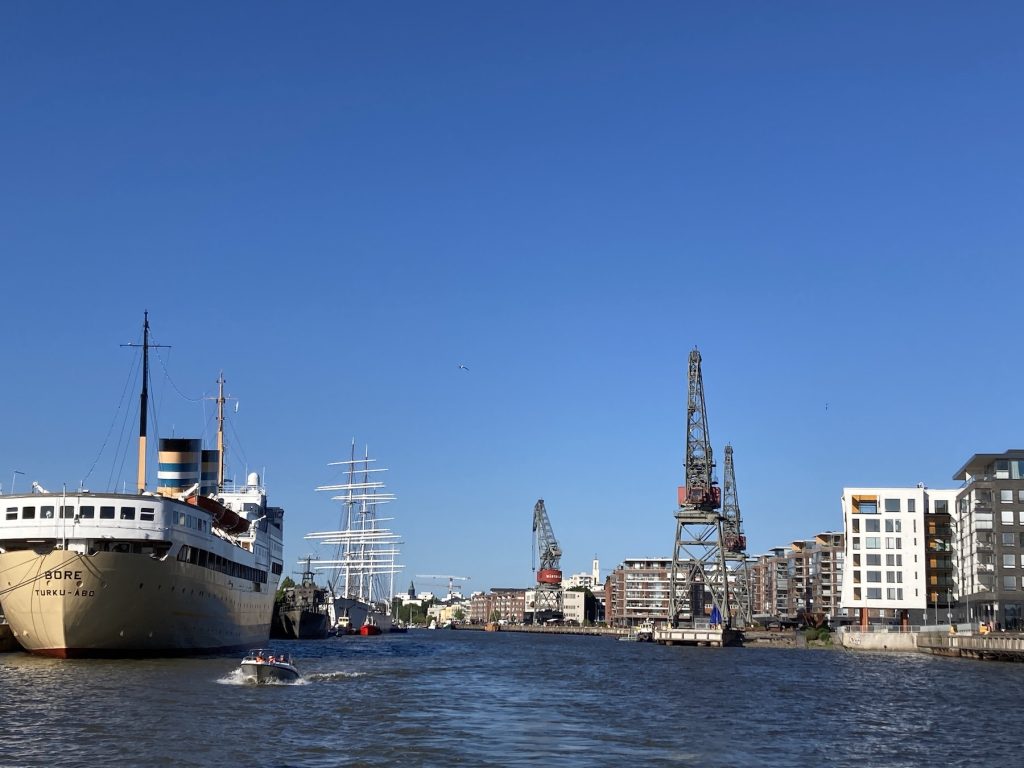
Workshop on Multifunctional Governance for Biodiversity
LANDPATHS researchers Michael Gilek, Mikael Karlsson and Neil Powell organized a workshop at NESS on multifunctional governance for biodiversity. Articles were presented on envisioning nature futures for Europe and, more specifically, on transformative initiatives for biodiversity restoration in the relation to the flower bulb industry in rural areas of the Netherlands.
Other submissions to the workshop were concerned with exploring concepts in connection with multifunctional landscapes such as social learning in multi-use forestry, area neutrality in city planning, and the implementation process of protected areas in marine and coastal areas. The latter study was presented by Charles Westerberg, PhD student in subproject marine and coastal landscapes. Most of the articles presented were qualitative studies. Nevertheless, one quantitative study assessed the acceptance of conservation policies.
Frida Öhman, PhD student in LANDPATHS subproject transformative governance pathways, presented a new framework for policy coherence for multifunctional landscape governance. The LANDPATHS review paper on landscape multifunctionality, co-ordinated by LANDPATHS programme leader Malgorzata Blicharska and co-authored by numerous LANDPATHS colleagues was also presented. The participants of the workshop had fruitful discussions regarding landscape approaches, methods and institutional challenges for halting biodiversity loss.
Towards Just & Plural Futures
Just one week after the NESS conference, the Political Ecology Network Conference POLLEN 2024 took place in Lund under the theme ‘Towards Just and Plural Futures’. At the conference, LANDPATHS PhD student Fanny Möckel discussed our ongoing work in collaboration with different biosphere reserves in Sweden, in a panel consisting of transdisciplinary researchers working with biosphere reserves and political ecologists. Guided by the question “How can Biosphere Reserves be Places of Environmental Justice?”, the panel explored the potential of biosphere reserves as places that address issues of environmental justice. Participants in the panel shared both empirical and theoretical insights into their work. They addressed different ways in which biosphere reserves can be places that enable just transformations towards more sustainable futures, and what such processes could look like.
Within the LANDPATHS programme, studies are being carried out in Voxnadalen, an established biosphere, and Nämdö Skärgård, a biosphere under establishment. In autumn 2024, LANDPATHS researchers together with local biosphere reserves will organize deliberative mini-publics.
The LANDPATHS sub-project Mountain Landscapes revolves around a literature study on the Swedish state’s attempts to create multifunctional mountain landscapes. The starting point is the Environmental Quality Objectives for the mountains, which emphasizes that a pasture-based mountain landscape depends on reindeer, and that reindeer depend on winter grazing in the forested areas. Below, researcher Stefan Sandström (SLU) tells us what we have learned so far about the state’s actions by looking back in history.
Regulation of conflicting interests through legislation
Preliminary results of the literature study show that the Swedish state has long grappled with the issue of planning for different interests and claims to land at the landscape level. The solution for landscape planning has often been through the implementation of new legislation. To some extent, this would solve conflicts of interest between different land use interests, and in other ways counteract undesired consequences of previous decisions. There are examples of such legislation that are over 100 years old. The Reindeer Grazing Act was introduced in 1886, at the same time as the introduction of private land ownership rights in the form of division of land and land consolidation was in its final phase. The Reindeer Grazing Act was supposed to be a tool for regulating the then opposing interests of reindeer husbandry and agriculture, but that was not the case in practice. Since then, the state has continued to try to reconcile these opposing interests, and new interests have emerged over time.
Complexity of interests and state organization complicate landscape planning
Early attempts to create multifunctional landscapes were based on different strategies. In some cases, it was believed that different interests could co-exist, while in others that certain interests could tolerate a certain degree of intrusion/restriction. It was also suggested that land use interests can be separated in time and space, in some contexts. Initially, land use interests were few and manageable. But as time has passed, the interests have become more numerous and harder to oversee.

At the same time, sustainability aspects have consistently shown a negative trend, especially regarding biodiversity, which the state has partially tried to counteract by establishing nature reserves since 1964.
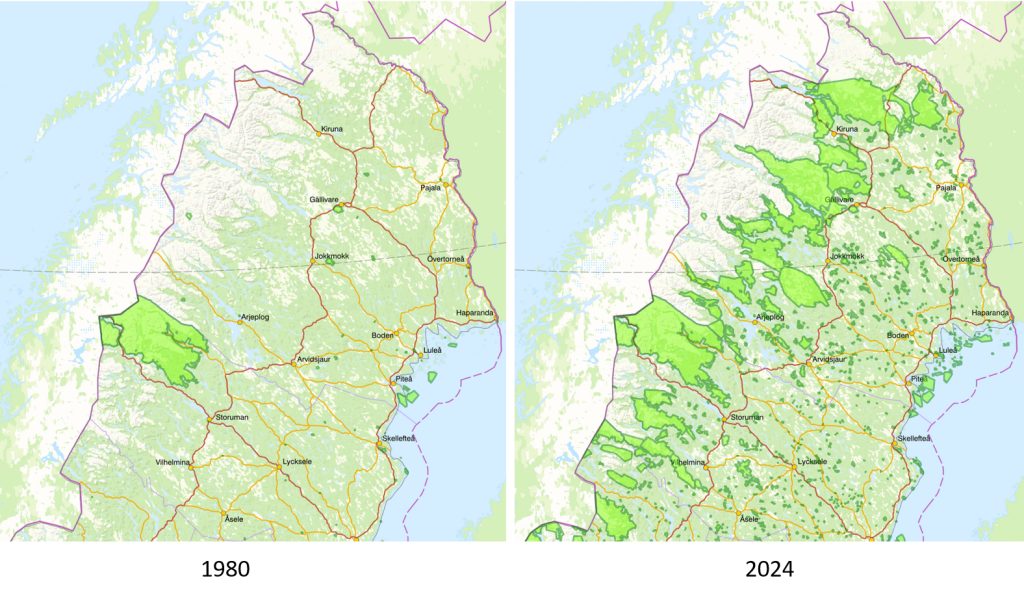
An obstacle to state landscape planning is that it has long been divided into sectors in which different authorities deal with their own topics separately in so-called ’silos’. This makes it difficult to oversee the cumulative effects that occur when many interests operate within the same landscape.
Persistent conflicts in mountain landscapes have become a legal issue
The original research question in the project has now become a legal issue. For the mountain area, this concerns hunting and fishing rights currently being investigated through the work of the state-led Committee on Reindeer Lands. Here, hunting interests are colliding with reindeer husbandry interests, and the issue has also taken on a political dimension with political parties taking different positions on the issue. In addition, a land conflict has recently arisen in the forested areas between Boden and Luleå, where landowners are questioning whether reindeer husbandry rights apply to their properties and whether reindeer grazing should be prohibited. Both of these conflicts have clear origins from conflicts that were supposed to be resolved with the first Reindeer Grazing Act of 1886.
Stabby woodland is located about 3 km west of Uppsala city center. The area consists of hills covered with mixed coniferous and deciduous trees and grasslands used for sheep grazing. Stabby woodland is a popular place for recreation for those living nearby. This year, the woodland became the stage for a student project in landscape architecture. Lara Tickle from LANDPATHs sub-project Urban Landscapes has been studying the project and tells us about how the students’ project promotes multifunctionality in urban woodlands.
Collaborative learning
In the LANDPATHS Urban Landscapes project we had the opportunity to follow and study the annual collaboration between the Swedish University of Agricultural Sciences (SLU) and Uppsala municipality. A greenspace within the municipality is selected for students to design and revitalise as part of SLU’s Landscape Architecture course ‘Design through practice and management’ (‘Gestaltning genom Förvaltning’). In 2023, the students, who have learned various theories and methods (including multifunctionality in the management of urban greenspaces) were assigned a large area of the Stabby woodland to apply their ideas. Here the students could work creatively with new theories in a bottom-up fashion, and in a collaborative and co-learning environment with employees at the municipality. In this way, they ‘started with the doing’ and not, as is so often the case, with policies and plans.

The project is seen as an exchange of learning and skills between the university and municipality. It is facilitated by the creative setting, space for experimentation and its bottom-up working structure led by the students. Over the years that the course has been running, students have learned how to work practically. In exchange, the municipality has picked up new strategies and methods for understanding and managing urban greenspaces. Discussions are also in process about the potential to apply this cooperative model in other Swedish municipalities interested in involving more landscape architects in the management of their urban greenspaces.
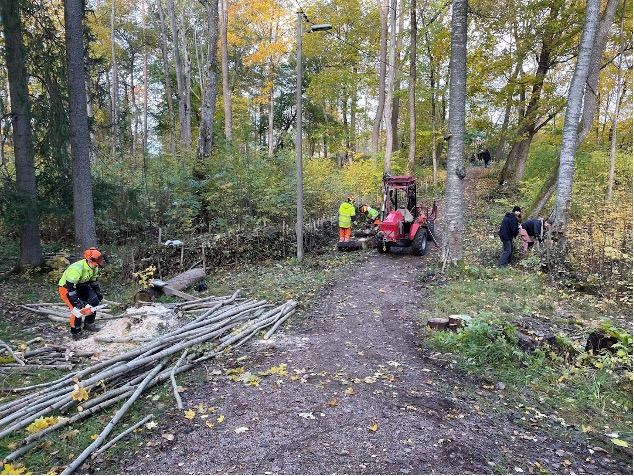
Managing urban woodlands
Urban woodlands are structurally similar to forests and are hubs of rich biodiversity in urban areas. They are highly popular spaces for locals and used in various ways, especially for health, recreation and educational purposes. Children from nearby schools often play amongst the trees and greenery. Joggers regularly run along the paths, passing others who are enjoying a daily stroll that enriches their mental health in a diverse and natural environment. The students considered all of these stakeholders, together with the concern for biodiversity, which was included in several ways. For example, prior practice by the municipality consisted of removing forest debris. The students inspired the idea of working with these local materials. Dead wood and other materials are considered a primary indicator of biodiversity in a forest ecosystem that houses and sustains many species and has therefore become a popular new method for working with biodiversity in design.
As a results of the students’ work, municipal foresters now aim to leave materials such as logs, leaves, branches and other debris in neat formations wherever they have been working. Students used and arranged these materials to make benches, play areas, hedges to emphasise a space or even weave local plants into a labyrinth for children to play in. Also, people from the municipality were encouraged to use their skills in other ways. For instance, one person who was especially skilled with a chainsaw made wooden sculptures to highlight features and species in an area.

Picture: Lara Tickle
“Doing things multifunctionally” in urban woodlands
During the collaborative work, we could observe how people apply principles of multifunctionality and nature-based thinking, or as one lecturer at the university says, “nature-based doing”. Students often strived to highlight or bring out certain features out of the landscape they were working in. For example, they scouted out and observed the area prior to the week in which they would be implementing their designs. After they had drawn up the plans that were presented to the municipality, one idea was selected as the main guide. Nevertheless, the work still allowed for a lot of freedom to try out other ideas on site. The co-creation process opened up new spaces and paths through the forest and refreshed old spaces. The students cleared overgrown paths and used woodchips from local roads to make easy walking or jogging paths. Historical sites were also enhanced visually in the landscape by clearing overgrown vegetation and placing benches close by. Furthermore, hedges were made from leaves and twigs to form habitats for insects.
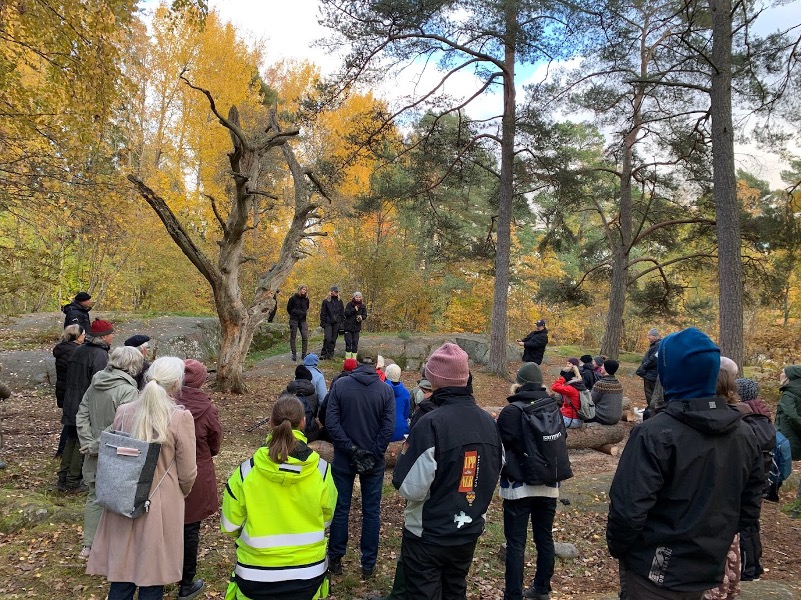
Evaluating and reflecting on the process
After an intense week of work in Stabby woodland the students presented their work to the public as part of a guided tour during an opening event. Each group presented the work they had done, as well the intentions behind their ideas and designs, who they were aimed at, and the qualities they tried to highlight and support in the woodland. In addition, department heads and other senior officials from the municipality emphasized during their presentation that the project was a successful cooperation between the two institutions.
In focus group meetings arranged by the LANDPATHS urban landscapes project, students mentioned that there are very many functions that need to be fulfilled by urban greenspaces, especially compared to other urban areas. They understand the challenges and difficulties that they can be faced with in their work, although this project still had a very positive atmosphere surrounding it. Engagement by local users of the woodland was high, and social values were very much highlighted in the woodland. Also, the importance of keeping areas like this one accessible to people in the city was raised, as such environments fill lots of important roles. Despite this, urban greenspaces face a lot of pressure.
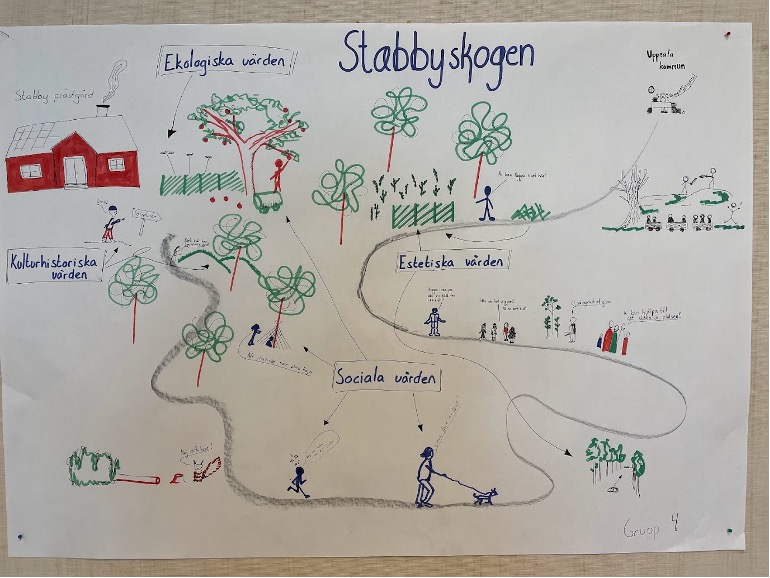
Foto: Lara Tickle
At the end of the annual collaboration the students reflected on these points and more through rich picture exercises and dialogue with LANDPATHS researchers. They emphasized that greenspaces are essential, yet while they continue to decline they must also fill a growing number of functions that are sometimes conflicting.
Citizen engagement and policy coherence for a sustainable transition
Frida Öhman and Fanny Möckel presented their research within Landpaths at the Beyond Crisis/Beyond normal conference arranged by the Norwegian University of Science and Technology (NTNU) in Trondheim. The conference participants, mainly researchers in social science and humanities, explored aspects of sustainability such as just transition and trade-offs across everyday life, politics, technology, art, and innovation through a broad range of disciplinary and cross-disciplinary perspectives. Main speakers were Kirsten Jenkins from University of Edinburgh, UK, Stuart Capstick from Cardiff University in Wales and Ferne Edwards from the University of Surrey, UK. The conference convened around twenty different sessions.

Engagement with citizens in landscape governance processes
Fanny, who is a PhD student at Uppsala university working in Landpaths subproject Barriers and Opportunities for Change, presented her work in the session “Building capacity for climate adaptation through involving citizens”. In her presentation she addressed the value of citizen engagement in deliberation and how such an approach can complement already-existing and more common stakeholder engagement processes. She highlighted “deliberative mini-publics” as a meaningful way to engage with citizens in broader landscape governance processes. The presentation was concluded with an outline of her planned case work within Landpaths. The audience showed great interest in the tool “deliberative mini-public” and was curious to see how this will be implemented in the Swedish cases within Landpaths.
An analytical framework to map policy coherence
Frida, also PhD student at Uppsala university, is working in Landpaths subproject Transformative governance pathways. She presented her work on governance analysis for promoting multifunctional landscapes in the session “Land use challenges”. Frida set the stage by reminding about the challenges caused by the multiplicity of sectoral policies that all aim to steer land use. Given the importance of analysing the coherence between such policies, Frida presented an analytical framework based on the European Landscape Convention. Participants joined the subsequent discussion with comments on policy coherence and landscape approaches also showing great interest in the research topic.
Topics connecting to research in Landpaths
Other sessions of the two-days long conference were on geographical perspectives, on just and sustainable transition and transition in tension, all sessions that invited for networking. Moreover, a session centring on bridging concerns for justice and speed elaborated on the dilemma of challenges and trade-offs of accelerated transitions; many aspects related to themes addressed in Landpaths. Sessions covered, for example, how to review and establish just and well-working environment/climate policies. In another session the audience listened to and discussed how the general public is involved and could be involved in transition periods towards a more sustainable future. All sessions carried the message that, while transitioning towards a more sustainable society, societal aspects such as policy acceptance, public engagement are highly relevant.

Network building and experiential workshop
Besides the more formal sessions, the conferences hosted several poster- and workshop sessions that invited for interaction with participants from all over Europe and beyond. Some of the presented projects were closely linked to Frida’s and Fanny’s work, and they valued a fruitful exchange of research interest and ideas across different geographical contexts. The two PhD students also participated in a workshop focusing on mapping. After a short presentation on the tool and exercise of creating a mental map of an experienced place, the group went for a walk to a close by park in Trondheim. The participants were asked to first experience the park while walking around in silence. In the second step, they drew a map of their experiences with closed eyes in order to capture the feeling of the place. Finally, in a group discussion, they discussed how such a tool can support the planning of specific places in times of transition.
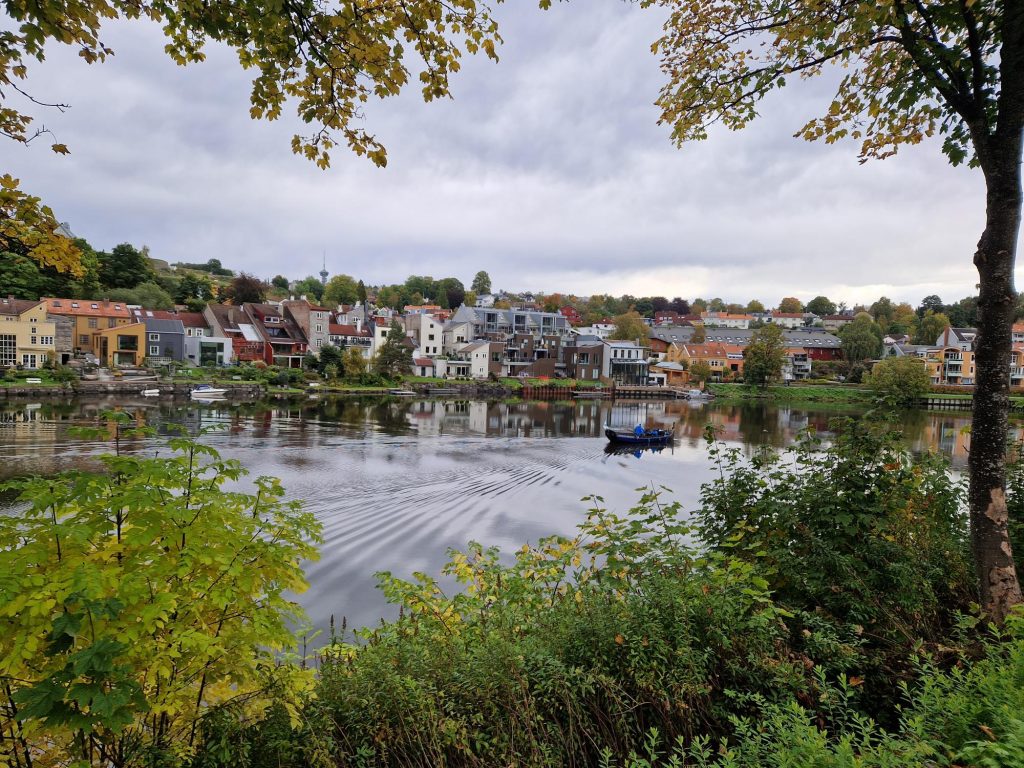
Train ride through mountain landscape
Going home from the conference by train through the beautiful autumn mountain landscape between Trondheim and Oslo gave Frida and Fanny the chance to digest all the knowledge and inspiration gained during the conference.
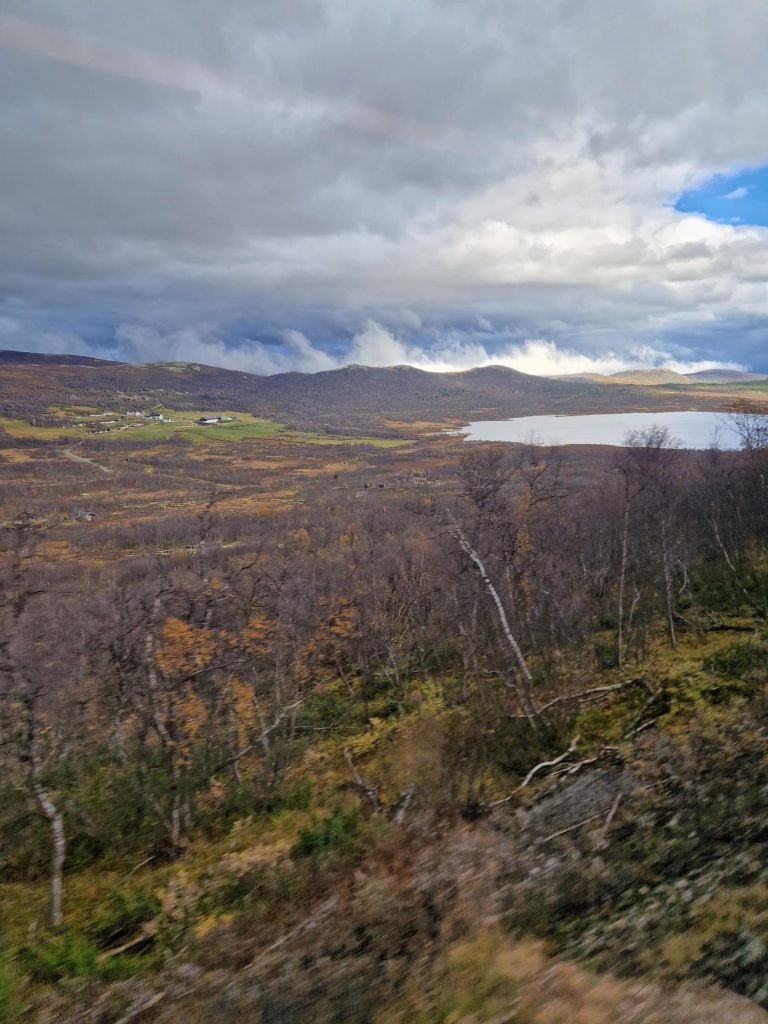
In this interview, Judith shares the scene with Max Whitman, a Uppsala University doctoral student affiliated with the LANDPATHS sub-project “Forest Landscapes” in Voxnadalen, and Hanna Alfredsson, coordinator for the Voxnadalen Biosphere Reserve in Hälsingland. The conversation revolves around LANDPATHS’ research in Voxnadalen, including focus group discussions and workshops with stakeholders, aimed at exploring and promoting multifunctionality within the forest landscape.
Biosphere Reserve Voxnadalen
Hanna explains the concept of biosphere reserves and Voxnadalen’s unique role in combining natural and cultural heritage with human well-being. She emphasizes the area’s focus on sustainable forest resources, vibrant water systems, and an open landscape. Voxnadalen officially became one of the world’s 740 UNESCO biosphere reserves in 2019, and the LANDPATHS project now focuses on gathering data and fostering dialogue for sustainable development. Hanna underscores the importance of supporting research to reduce polarization in forest debates and achieve Agenda 2030 goals.
Hanna adds “Many of us here are very excited to see what this project or Landpaths can lead to and what it will lead to in practical terms for us and how it can contribute to, for example, a reduced polarization in the forestry debate. And how we can share these experiences also within the network of biosphere reserves. We are very happy to be part of this.“
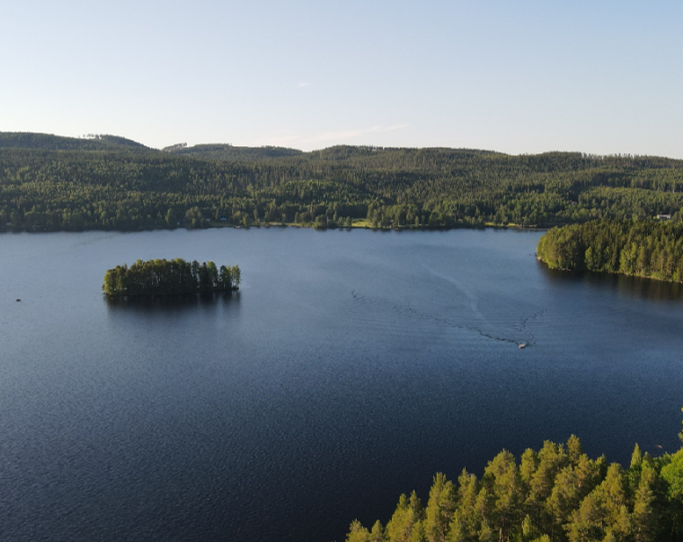
Voxnadalen as a Study Object in LANDPATHS
Voxnadalen was chosen by sub-project forest landscapes in LANDPATHS due to its biosphere reserve status and commitment to sustainable forestry. Max shares insights from his research project, highlighting collaborative efforts with other researchers, such as Forest landscape subproject leader Sara Holmgren, researchers Neil Powell and Thao Do in subproject Future Imaginaries for method development, and practitioners in Voxnadalen. Their co-creative research aims to understand and promote multifunctionality in the forest landscape through open workshops and focus discussions with various stakeholders.
“We don’t really define our study. We do not come in and say that this is what we are looking at specifically, but we will try to come in with a very open mind and listen and talk to people like Hanna and a lot of other actors in the region to understand what the problems are here. What are the opportunities? What is it that is good? How can we find synergies and create innovations to promote sustainable use of the forest? And in that process understand what is a multifunctional forest landscape and how can we promote it simply?”
Creating Common Visions through Co-Creation
During one of the workshops, the research team encouraged participants to create a headline for a fictitious documentary about Voxnadalen in 2050. Examples included ‘Biosphere reserve used but not consumed,’ emphasizing intangible cultural heritage and questions of cultivation, ownership, and the relationship between them. Another headline, ‘Biosphere Reserve Voxnadalen leads the way to sustainable forestry,’ reflects the ambition to use the biosphere reserve designation as an opportunity to lead in sustainable forestry through education and other initiatives. Other headlines like ‘Diversity, multiple use, and multifunctionality’ and ‘Faith in the future grows in Voxnadalen’s’ encompass knowledge elevation beyond economic aspects, emphasizing collaboration and coordination.
“So we had quite a bit of fun with the headlines and had some that were funny as well in what is it we don’t want to see? And then there were things like ’Voxnadalen is the largest clearcut’. “
New Value Chain Contributes to Innovation and Sustainable Forestry
Both Hanna and Max stress the importance of dialogue among different actors and stakeholders to understand and promote multifunctionality in the forest landscape. They mention examples like Voxkedjan, an economic association connecting the needs of Helsinge farms for quality timber with contributions from private forest owners, supported by sawmills and processed by Voxkedjan members. The initiative demonstrates the possibilities of creating new value chains for more sustainable forestry while fostering collaboration within the sector.
“In Voxnadalen […] there is a willingness to listen to each other to a greater extent. I think that’s very good because when you start going into ‘okay, what do we mean by sustainable forestry? What is the role of forests in promoting regional development?’ That’s where you can start creating meaning and common visions and also look at building collaborations and promoting innovations,” says Max to summarize his impressions in Voxnadalen.
Multifunctionality – a difficult term in practice
In the interview, the concept of “multifunctionality” is also discussed. Max emphasizes that it can be challenging to explain to individual actors, as it is perceived as abstract. He stresses that the work towards multifunctionality does not follow a linear process with a shared vision implemented backwards. Instead, it involves asking questions and promoting innovations beyond traditional forestry, as seen in the example of Voxkedjan.
Hanna agrees and notes that the term “multifunctionality” was not common among Voxnadalen stakeholders before their participation in the project. She shares the view of creating diversity and infrastructure to promote new ideas and innovations as a path towards multifunctionality within the area, including activities like fishing, tourism, and other industries.
Understanding and Openness Foster Sustainable Forestry
Finally, both Max and Hanna emphasize the importance of working towards sustainable solutions and creating understanding and openness between different perspectives within the forestry sector. Voxnadalen serves as a model for how a biosphere reserve can actively engage in research projects to promote a sustainable future. The research team looks forward to continuing collaboration and exploring opportunities for multifunctionality in forestry in Voxnadalen and beyond.
The full interview (in Swedish) can be found below.
We live in a rapidly changing world with complex challenges. Envisioning future landscapes that harmoniously balance biodiversity with different land uses and the interests of diverse stakeholders is a difficult task that demands creative and collaborative efforts. Researchers in LANDPATHS subproject “Imaginaries” (SP2) are embarking on a journey towards shaping these desirable futures through a co-creation approach. This involves using the collective knowledge of stakeholders and citizens to address multifaceted challenges.
Navigating complexity: challenges and uncertainties
Landscapes are interconnected systems. As a result, even well-intentioned interventions that improve conditions for one group of stakeholders can unexpectedly cause challenges for others. Taking the example of forest landscapes, there are many different stakeholders concerned with the use of those landscapes, including residents, agencies, forest owners, reindeer herders and people using forests for recreation, to name a few. These groups can have different values and ideas about the future of the landscape. At the same time, science-based criteria related to climate change and nature conservation may impose other constraints on how we manage and use forests in the future. Together, these factors can make it difficult to imagine future multifunctional landscapes where the diverse aims and interests of stakeholders can co-exist.
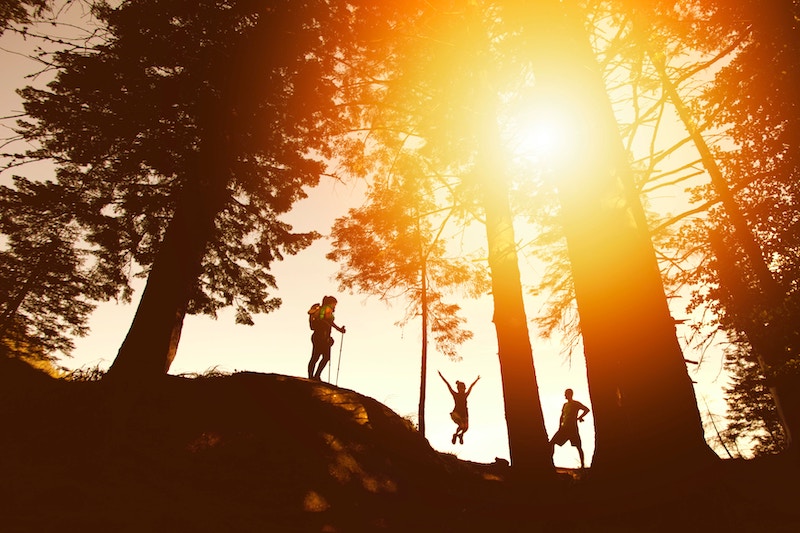


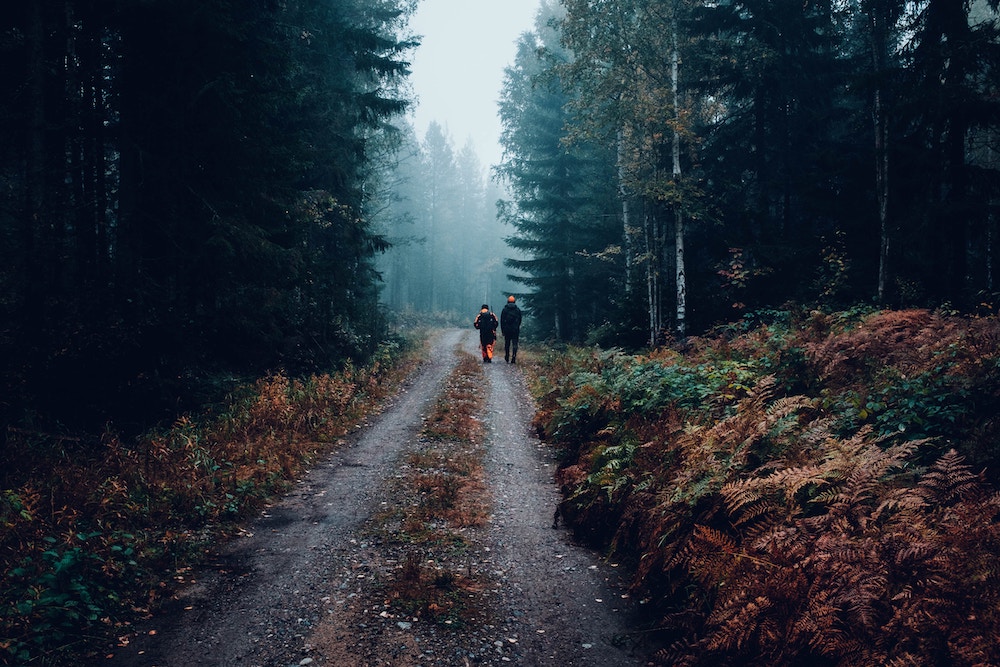
Creating the basis for co-creation
As part of the co-creation process, we need to unravel the perspectives of the various stakeholders and the potential differences between their visions for the future and science-based criteria.
To do this, LANDPATHS researchers have developed an iterative process for co-creating future visions (also called imaginaries) with stakeholders and citizens in different landscapes in Sweden. The process consists of four phases:
- Scoping and framing
- Developing imaginaries
- Iterative revision of imaginaries
- Governance learning
In a collaboration with the Forest landscape subproject (SP5), researchers are working with the Voxnadalen Biosphere to explore future imaginaries of multifunctional forests (read more about this case on our blog).
In Voxnadalen, the co-creation process will unfold through a series of workshops with local stakeholders such as municipalities, forest owners, forest companies, nature conservation associations, tourism companies and hunting groups. The aim of the workshops is to shed light on both established and new visions of forest futures, by exploring potential synergies that emerge from the discussions and creating innovations that can support more multifunctional and biodiverse forest landscapes in the future.

Co-creation for transformation
In light with the co-creation approach, participants are seen as co-designers of the future – they contribute to a transformation process with their knowledge, perspectives and values. This fosters an environment of creativity, exploration, and experimentation and unlocks a realm of possibilities. Possible outcomes are stories and visions that embrace the richness and diversity of values and perspectives of participants and challenge traditional power structures.
One method being used in the co-creation process is the co-design of a board game that participants with diverse interests can play together. The game allows them to experiment with different possible futures and to test actions and responses in a playful, inconsequential setting. While competing interests and unequal power relations can make it difficult to reach a solution in real life, the game allows participants to test and evaluate scenarios in a way where diverse forms of knowing and acting are less distorted by power relations. The researchers are also using anticipatory narratology, a technique that is based on stories and storytelling to craft future narratives. Together, these methods help to create a safe space for the participants to talk about alternative futures. They also enable stakeholders to navigate the complexities they are faced with and reflect upon their actions in the face of uncertainty. In this co-learning environment, novel governance arrangements can emerge to support the realization of their landscape imaginaries.

Embarking on a journey of transformation
Through this research, SP2 aims to shed light on innovative pathways towards multifunctional biodiverse landscapes. By harnessing the power of co-creation, the aspiration is that stakeholders feel empowered to imagine and design transformations that overcome traditional barriers and sectoral silos. As the work unfolds, it invites us all to become co-designers of alternative futures that reflect a mosaic of perspectives and values.
For more information about the Imaginaries subproject, contact the research team (and link to SP2 page).
We thank Thao Do (subproject Imaginaries) for valuable input into this blogpost.
The coordinating subproject (SP1) of LANDPATHS welcomed Laoise Ní Mharcaigh, third-year BSc student in Sustainability with Social Sciences, Policy and Law at University College Dublin (UCD), Ireland this summer to contribute to a review of academic literature on the barriers and opportunities for multifunctional biodiverse landscapes in Sweden.
LANDPATHS attracts student from Dublin for an internship
Laoise’s particular interests in biodiversity conservation, environmental education and citizen science and her connection to Sweden, where she has family living on Gotland, led her to discover the LANDPATHS research programme. After securing an academic scholarship from UCD’s Ad Astra Academy to cover the costs of her trip and stay in Sweden, Laoise proactively got in touch with LANDPATHS project coordinator Malgorzata (Gosia) Blicharska to explore options for a short internship within the programme.
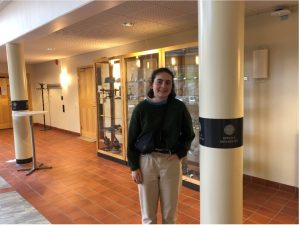
Laoise at Geocentrum, Uppsala University
My task was to read and review a set of academic articles about various aspects of multifunctionality in Sweden’s landscapes. I started reviewing the articles in early July, picking out relevant information for the work in LANDPATHS.
Barriers and opportunities for multifunctionality reported in academic literature
Jayne Glass, a researcher in the LANDPATHS team, supported Laoise through regular advice and discussion. When Laoise came to Uppsala in early August, she continued her work in the Department of Earth Sciences, identifying the potential barriers and opportunities for multifunctionality that were evident in the papers she reviewed. She then presented and discussed her work with Gosia and Jayne, to identify recurrent themes and contribute to their plans for upcoming work on multifunctionality in LANDPATHS.
We asked Laoise what she had learned about multifunctional landscapes through her work.
Throughout my degree programme, my main focus has predominantly been situated in the realm of climate justice and environmental governance. In terms of my initial understanding of multifunctionality, I had not had much exposure other than what I had learned during a module on land-use and its environmental impact. However, coming from a rural background, I have always been aware of the ability of landscapes to provide several functions, namely the ecological, cultural and economic values of agricultural farmland. As such, I found the opportunity to delve into articles based on multifunctionality in the Swedish landscape to be hugely insightful. Most notably, the importance of forests as multifunctional landscapes and the range of roles that they play in Sweden was particularly interesting, as it is something that is not as prominent in the Irish landscape.
Potential for more public involvement in Swedish landscape policy-making?
Several of the articles Laoise reviewed referred to the importance of engaging stakeholders and citizens in decision-making about multifunctional landscapes. This raised questions in Laoise’s mind about the extent to which the public can influence land use decisions and policy in Sweden. This resonates well with the co-creation approach to stakeholder and citizen engagement in the LANDPATHS research.
Reviewing the articles has been hugely beneficial for me in that I was also able to get a strong insight into Swedish policy surrounding land-use and multi-actor governance. Following the recent nationally-led Citizen’s Assembly on Biodiversity Loss in Ireland, it was interesting to note a lack of public involvement in Swedish landscape policy-making. A Swedish Citizen’s Assembly Model could perhaps be looked at in the future.
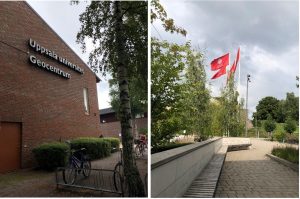
Picture credit: Laoise Ní Mharcaigh
Literature synthesis on multifunctionality in Sweden
Laoise’s work will contribute to the ongoing research by the LANDPATHS team into the barriers to multifunctionality and the potential opportunities that exist for the future in the different landscapes that they are working in – forest, agricultural, urban, marine and coast, and mountain landscapes. In the coming months, Gosia and Jayne will be working with others in the team on an academic paper about multifunctionality in Sweden. The work Laoise did over the summer will be used in this article and we hope to remain in contact with Laoise as the paper develops. Laoise plans to bring the insights she gained about sustainable land-use from the Swedish perspective into the remainder of her degree at UCD.
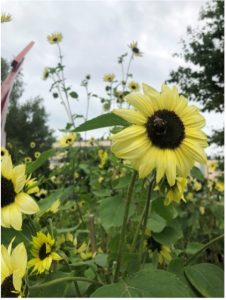
Picture credit: Laoise Ní Mharcaigh
Experiencing Sweden and Uppsala
This internship, created by Laoise’s own initiative and hosted by LANDPATHS, has also been a great opportunity for Laoise to discover Sweden. She describes her experience working at a Swedish university and discussing with researchers and students as insightful and she is hoping to undertake an Erasmus exchange with Lund University in January 2024.
My recent trip to Sweden and in particular to Uppsala University has been amazing. Having only been to Gotland on previous trips, I was unsure of what to expect. However, travelling by myself to Uppsala, I felt very safe in my surroundings. It was very encouraging to visit a city where bike travel seemed to be the way to go, something that I can definitely take back with me to Ireland. I loved the feeling of walking around the city, with lots of green spaces and mature trees at every turn. My experience with visiting the University has been more than I could have asked for – I felt very welcome during my stay. Everyone that I met was very friendly and interested in hearing about my experience in Uppsala – all I can say is how I look forward to coming back!
We are delighted to have met Laoise and we are grateful for her hard work and helpful contributions to the LANDPATHS programme. We wish her all the best with her studies and hope to see her in Uppsala again soon!

LANDPATHS subproject “Marine and coastal landscapes” focusses on the management of conflicts in coastal/marine biosphere reserves linked to the UNESCO Man and Biosphere (MAB) programme. Researchers in this subproject study how biospheres interact with wider multi-level and multi-sector governance arrangements such as marine spatial planning. Researchers in this subproject have recently selected Nämdo archipelago as one of the areas for their case study. PhD student Charles Westerberg reports about their first visit to the largest island.
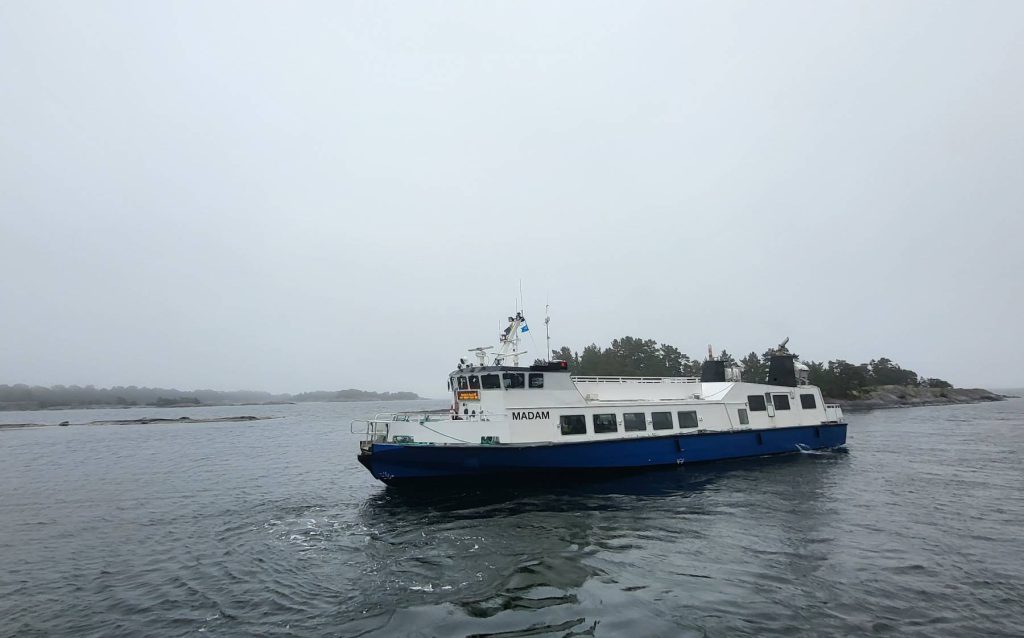
Nämdö archipelago, which consists of hundreds of islands, is located a few hours away from Stockholm and is part of Värmdö municipality. Approximately 30 of the islands are inhabited, with Nämdö being the largest. Nämdö is highly valued by both residents and visitors due to its natural and cultural significance. The archipelago is also home to several nature reserves that are part of the European network Natura 2000, areas containing high biodiversity and exceptional beauty.
Preparation to become a new Biosphere Reserve
As part of LANDPATHS subproject Coastal and marine landscapes, the archipelago will serve as a case study in their preparation process of a new Biosphere Reserve. The goal is to explore how conflicts can be identified and resolved through proposed measures and compromises. Additionally, we are considering collaborating with subproject Barriers and opportunities for change to conduct a citizen mini-public or jury. This engagement approach has been shown to successfully raise awareness and acquire informed feedback from local citizens.
Visiting Nämdö
On April 25th, researchers from both subprojects travelled to Stavsnäs and met with members from the Nämdö Green Archipelago (NGA) group. NGA was founded in 2020 to facilitate sustainable rural development in the archipelago. They are currently working on a pilot study to nominate Nämdö archipelago as a UNESCO Biosphere Reserve, a process that involves extensive mapping and stakeholder consultations.

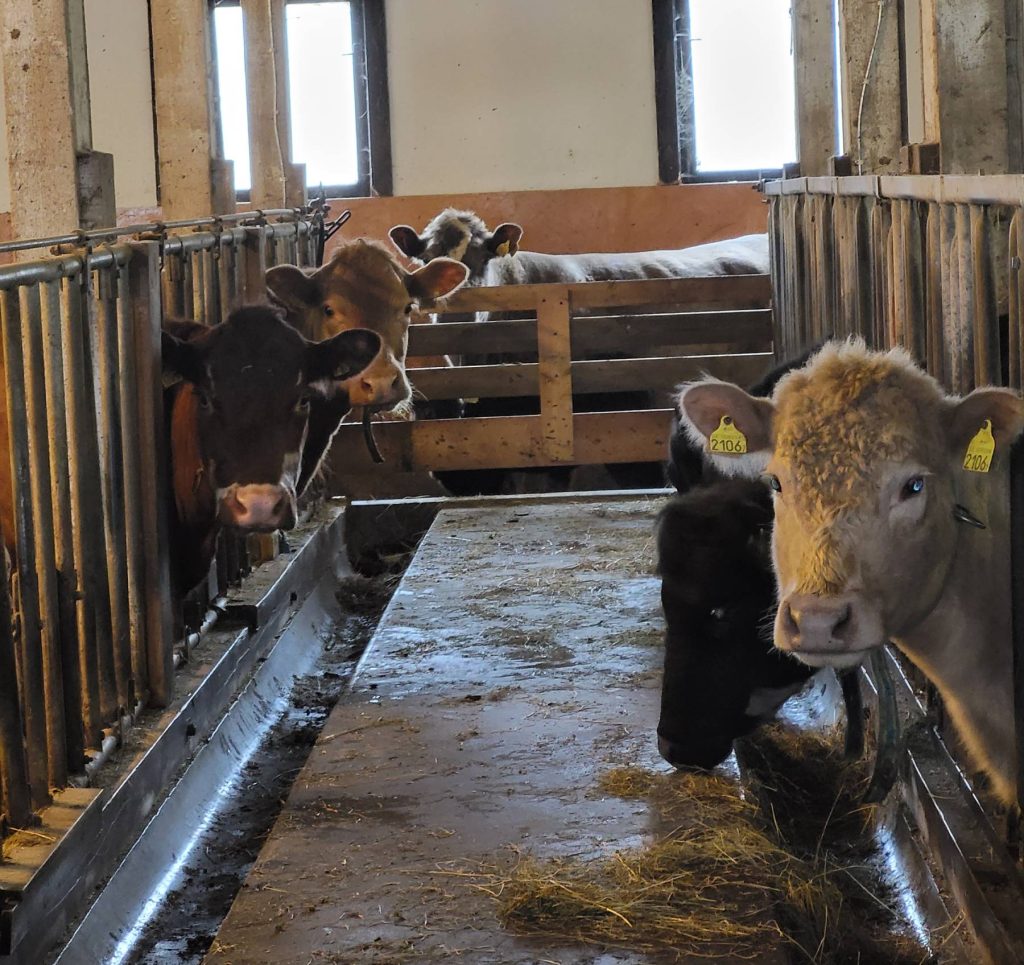
After a scenic boat ride from Stavsnäs, we arrived on Nämdö island and had the opportunity to meet with residents and visit local hotspots and businesses. Throughout the day, we were introduced to some of the challenges facing Nämdö and its people, such as a declining and aging population, the costs of nature conservations, concerns regarding land ownership, and limited livelihood options. These are just a few of the issues that NGA is hoping to address.
Our work with Nämdö will be ongoing throughout the LANDPATHS project, and we are excited to see how the Biosphere Reserve process will develop.
